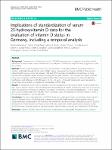Implications of standardization of serum 25-hydroxyvitamin D data for the evaluation of vitamin D status in Germany, including a temporal analysis
Rabenberg, Martina
Scheidt-Nave, Christa
Busch, Markus A.
Thamm, Michael
Rieckmann, Nina
Durazo-Arvizu, Ramón A.
Dowling, Kirsten G.
Škrabáková, Zuzana
Cashman, Kevin D.
Sempos, Christopher T.
Mensink, Gert
Background:
Comparability of 25-hydroxyvitamin D (25(OH)D) measurements is hampered by method-related differences in measurement values. International standardization of laboratory assays has been suggested to solve this problem.
Methods:
As part of the European Commission–funded project ‘Food-based solutions for optimal vitamin D nutrition and health through the life cycle’ (ODIN), original measurements of serum 25(OH)D of three German national health surveys conducted between 1998 and 2011 have been standardized retrospectively. In these representative population-based samples including persons aged between 1 and 79 years, the original 25(OH)D values were compared with those after standardization. Mean values and prevalences of vitamin D deficiency, insufficiency, and sufficiency (25(OH)D levels < 30, 30- < 50, and > =50 nmol/l, respectively) were calculated by sex and age groups based on original and standardized 25(OH)D data.
Results:
In comparison to the original 25(OH)D levels, the standardized levels showed higher means overall and in age- and sex-specific analyses. After standardization, the prevalence of vitamin D deficiency was lower in all surveys while the prevalence of vitamin D sufficiency was higher. Nevertheless, even after standardization ~ 15% of adults and 12.5% of children had serum 25(OH)D levels < 30 nmol/l. Thus, the proportion of deficient vitamin D levels in the German population is still considerable.
Conclusions:
The use of standardization of 25(OH)D levels has a substantial impact on estimates of the vitamin D status in Germany. Since clinical diagnostic, therapeutic and public health decision-making require valid and comparable data, standardization and calibration of commercial, clinical and research laboratory assays for 25(OH)D measurement should become common practice. Until then, researchers, health practitioners and policy makers should be aware of the peculiarities of the measurement methods when comparing and interpreting 25(OH)D levels.
Dateien zu dieser Publikation

